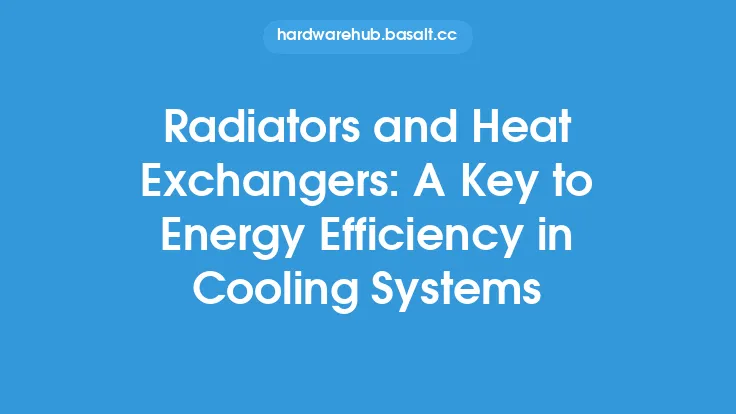When it comes to silent cooling systems, the materials used play a crucial role in determining their effectiveness and overall performance. These systems are designed to minimize noise while maintaining optimal cooling, making them ideal for applications where quiet operation is essential, such as in home theaters, recording studios, and even in high-performance computing where fan noise can be a distraction. The choice of materials in silent cooling systems is not just about thermal conductivity or durability; it's also about reducing vibration and noise transmission. In this context, understanding the materials used in these systems can provide insights into how they achieve silent operation without compromising on cooling efficiency.
Introduction to Materials in Silent Cooling
The primary goal of silent cooling systems is to reduce the noise generated by traditional cooling methods, such as fans and pumps, without sacrificing the system's ability to dissipate heat. This is achieved through the use of specialized materials and designs that either absorb noise, reduce vibration, or enhance thermal conductivity. Materials like copper, aluminum, and graphite are commonly used for their high thermal conductivity, allowing for efficient heat transfer from the source to the cooling medium. Additionally, materials with high density and specific heat capacity are preferred for their ability to absorb and dissipate heat effectively.
Thermal Interface Materials
Thermal interface materials (TIMs) are critical in silent cooling systems as they facilitate the transfer of heat from the heat source (e.g., a CPU or GPU) to the cooling system. TIMs can be in the form of thermal tapes, greases, or pads. They are designed to fill microscopic gaps between the heat source and the cooling system, ensuring maximum contact and thus, efficient heat transfer. The choice of TIM depends on the application, with some offering higher thermal conductivity, others providing better durability, and some being more suitable for specific temperature ranges. In silent cooling systems, the focus is not only on high thermal conductivity but also on the material's ability to maintain its properties over time and under various operating conditions.
Heat Sinks and Their Materials
Heat sinks are a fundamental component of silent cooling systems, designed to increase the surface area of the heat source, allowing for more efficient heat dissipation. The materials used for heat sinks are typically those with high thermal conductivity. Copper is often preferred due to its excellent thermal conductivity, although it can be expensive and heavy. Aluminum is another common material, offering a good balance between cost, weight, and thermal performance. In some cases, especially where weight is a concern, graphite or carbon fiber heat sinks might be used, offering high thermal conductivity with reduced weight. The design of the heat sink, including its fins and base, is also crucial for silent operation, as it affects airflow and thus, noise levels.
Fan and Pump Materials
While silent cooling systems aim to minimize the use of fans and pumps due to their noise, when they are used, the materials from which they are made can significantly impact the overall noise level. For instance, fans with blades made from materials that are less prone to vibration, such as certain plastics or composites, can reduce noise. Similarly, pumps used in liquid cooling systems can be designed with materials that dampen the sound of flowing liquid or reduce the vibration that causes noise. The bearings used in fans and pumps are also critical, with some materials and designs offering smoother, quieter operation than others.
Noise Reduction Materials
In addition to the materials used for thermal management, silent cooling systems often incorporate materials specifically designed to reduce noise. These can include sound-absorbing materials used in the casing of the system, vibration-dampening materials used in mounts and fasteners, and even materials used in the ducting and tubing of liquid cooling systems to reduce the transmission of sound. The use of these materials requires a deep understanding of acoustics and the specific noise profiles of the components involved, allowing for targeted noise reduction strategies.
Advanced Materials and Technologies
The field of silent cooling is continuously evolving, with advancements in materials science and technology offering new possibilities for silent cooling systems. For example, the development of nanomaterials and metamaterials with tailored thermal and acoustic properties can lead to more efficient and quieter cooling solutions. Similarly, advancements in 3D printing and additive manufacturing are enabling the creation of complex geometries and structures that can enhance thermal performance while minimizing material use and potentially reducing noise. The integration of smart materials that can adapt to changing thermal conditions or actively control noise levels is also an area of ongoing research and development.
Conclusion
The materials used in silent cooling systems are diverse and play a critical role in achieving the balance between cooling efficiency and quiet operation. From traditional materials like copper and aluminum to advanced composites and smart materials, the choice of material is influenced by factors such as thermal conductivity, durability, weight, and cost. As technology advances, we can expect to see the development of new materials and technologies that further enhance the performance of silent cooling systems, making them even more effective and quieter. Understanding these materials and their applications is essential for designing and optimizing silent cooling solutions for a wide range of applications, from consumer electronics to industrial equipment.





